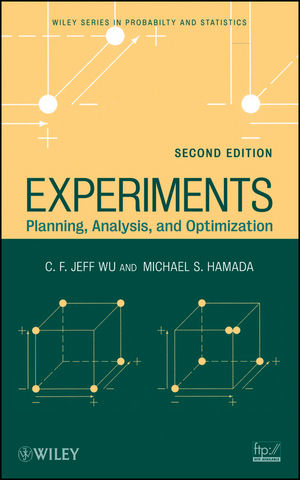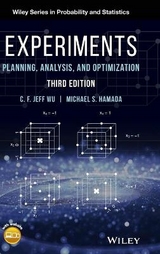
Experiments
John Wiley & Sons Inc (Verlag)
978-0-471-69946-0 (ISBN)
Praise for the First Edition: "If you . . . want an up-to-date, definitive reference written by authors who have contributed much to this field, then this book is an essential addition to your library."
—Journal of the American Statistical Association
Fully updated to reflect the major progress in the use of statistically designed experiments for product and process improvement, Experiments, Second Edition introduces some of the newest discoveries—and sheds further light on existing ones—on the design and analysis of experiments and their applications in system optimization, robustness, and treatment comparison. Maintaining the same easy-to-follow style as the previous edition while also including modern updates, this book continues to present a new and integrated system of experimental design and analysis that can be applied across various fields of research including engineering, medicine, and the physical sciences.
The authors modernize accepted methodologies while refining many cutting-edge topics including robust parameter design, reliability improvement, analysis of non-normal data, analysis of experiments with complex aliasing, multilevel designs, minimum aberration designs, and orthogonal arrays. Along with a new chapter that focuses on regression analysis, the Second Edition features expanded and new coverage of additional topics, including:
Expected mean squares and sample size determination
One-way and two-way ANOVA with random effects
Split-plot designs
ANOVA treatment of factorial effects
Response surface modeling for related factors
Drawing on examples from their combined years of working with industrial clients, the authors present many cutting-edge topics in a single, easily accessible source. Extensive case studies, including goals, data, and experimental designs, are also included, and the book's data sets can be found on a related FTP site, along with additional supplemental material. Chapter summaries provide a succinct outline of discussed methods, and extensive appendices direct readers to resources for further study.
Experiments, Second Edition is an excellent book for design of experiments courses at the upper-undergraduate and graduate levels. It is also a valuable resource for practicing engineers and statisticians.
C. F. Jeff Wu, PhD, is Coca-Cola Professor in Engineering Statistics at the Georgia Institute of Technology. Dr. Wu has published more than 130 papers and is the recipient of numerous accolades, including the National Academy of Engineering membership and the COPSS Presidents' Award. Michael S. Hamada, PhD, is Statistical Scientist at Los Alamos National Laboratory in New Mexico. Dr. Hamada is a Fellow of the American Statistical Association and the author of more than seventy published papers.
Preface to the Second Edition. Preface to the First Edition.
Suggestions of Topics for Instructors.
List of Experiments and Data Sets.
1 Basic Concepts for Experimental Design and Introductory Regression Analysis.
1.1 Introduction and Historical Perspective.
1.2 A Systematic Approach to the Planning and Implementation of Experiments.
1.3 Fundamental Principles: Replication, Randomization, and Blocking.
1.4 Simple Linear Regression.
1.5 Testing of Hypothesis and Interval Estimation.
1.6 Multiple Linear Regression.
1.7 Variable Selection in Regression Analysis.
1.8 Analysis of Air Pollution Data.
1.9 Practical Summary.
2 Experiments with a Single Factor.
2.1 One-Way Layout.
2.2 Multiple Comparisons.
2.3 Quantitative Factors and Orthogonal Polynomials.
2.4 Expected Mean Squares and Sample Size Determination.
2.5 One-Way Random Effects Model.
2.6 Residual Analysis: Assessment of Model Assumptions.
2.7 Practical Summary.
3 Experiments with More Than One Factor.
3.1 Paired Comparison Designs.
3.2 Randomized Block Designs.
3.3 Two-Way Layout: Factors With Fixed Levels.
3.4 Two-Way Layout: Factors With Random Levels.
3.5 Multi-Way Layouts.
3.6 Latin Square Designs: Two Blocking Variables.
3.7 Graeco-Latin Square Designs.
3.8 Balanced Incomplete Block Designs.
3.9 Split-Plot Designs.
3.10 Analysis of Covariance: Incorporating Auxiliary Information.
3.11 Transformation of the Response.
3.12 Practical Summary.
4 Full Factorial Experiments at Two Levels.
4.1 An Epitaxial Layer Growth Experiment.
4.2 Full Factorial Designs at Two Levels: A General Discussion.
4.3 Factorial Effects and Plots.
4.4 Using Regression to Compute Factorial Effects.
4.5 ANOVA Treatment of Factorial Effects.
4.6 Fundamental Principles for Factorial Effects: Effect Hierarchy, Effect Sparsity, and Effect Heredity.
4.7 Comparisons with the "One-Factor-at-a-Time" Approach.
4.8 Normal and Half-Normal Plots for Judging Effect Significance.
4.9 Lenth's Method: Testing Effect Significance for Experiments Without Variance Estimates.
4.10 Nominal-the-Best Problem and Quadratic Loss Function.
4.11 Use of Log Sample Variance for Dispersion Analysis.
4.12 Analysis of Location and Dispersion: Revisiting the Epitaxial Layer Growth Experiment.
4.13 Test of Variance Homogeneity and Pooled Estimate of Variance.
4.14 Studentized Maximum Modulus Test: Testing Effect Significance for Experiments with Variance Estimates.
4.15 Blocking and Optimal Arrangement of 2k Factorial Designs in 2q Blocks.
4.16 Practical Summary.
5 Fractional Factorial Experiments at Two Levels.
5.1 A Leaf Spring Experiment.
5.2 Fractional Factorial Designs: Effect Aliasing and the Criteria Of Resolution and Minimum Aberration.
5.3 Analysis of Fractional Factorial Experiments.
5.4 Techniques for Resolving the Ambiguities in Aliased Effects.
5.5 Selection of 2k-p Designs Using Minimum Aberration and Related Criteria.
5.6 Blocking in Fractional Factorial Designs.
5.7 Practical Summary.
6 Full Factorial and Fractional Factorial Experiments at Three Levels.
6.1 A Seat-Belt Experiment.
6.2 Larger-the-Better and Smaller-the-Better Problems.
6.3 3k Full Factorial Designs.
6.4 3k-p Fractional Factorial Designs.
6.5 Simple Analysis Methods: Plots and Analysis of Variance.
6.6 An Alternative Analysis Method.
6.7 Analysis Strategies for Multiple Responses I: Out-of-Spec Probabilities.
6.8 Blocking in 3k and 3k-p Designs.
6.9 Practical Summary.
7 Other Design and Analysis Techniques for Experiments at More Than Two Levels.
7.1 A Router Bit Experiment Based on a Mixed Two-Level and Four-Level Design.
7.2 Method of Replacement and Construction of 2m4n Designs.
7.3 Minimum Aberration 2m4n Designs with n = 1, 2.
7.4 An Analysis Strategy for 2m4n Experiments.
7.5 Analysis of the Router Bit Experiment.
7.6 A Paint Experiment Based on a Mixed Two-Level and Three-Level Design.
7.7 Design and Analysis of 36-Run Experiments at Two And Three Levels.
7.8 rk-p Fractional Factorial Designs for any Prime Number r.
7.9 Related Factors: Method of Sliding Levels, Nested Effects Analysis, and Response Surface Modeling.
7.10 Practical Summary.
8 Nonregular Designs: Construction and Properties.
8.1 Two Experiments: Weld-Repaired Castings and Blood Glucose Testing.
8.2 Some Advantages of Nonregular Designs Over the 2k-p and 3k-p Series of Designs.
8.3 A Lemma on Orthogonal Arrays.
8.4 Plackett-Burman Designs and Hall's Designs.
8.5 A Collection of Useful Mixed-Level Orthogonal Arrays.
8.6 Construction of Mixed-Level Orthogonal Arrays Based on Difference Matrices.
8.7 Construction of Mixed-Level Orthogonal Arrays Through the Method of Replacement.
8.8 Orthogonal Main-Effect Plans Through Collapsing Factors.
8.9 Practical Summary.
9 Experiments with Complex Aliasing.
9.1 Partial Aliasing of Effects and the Alias Matrix.
9.2 Traditional Analysis Strategy: Screening Design and Main Effect Analysis.
9.3 Simplification of Complex Aliasing via Effect Sparsity.
9.4 An Analysis Strategy for Designs with Complex Aliasing.
9.5 A Bayesian Variable Selection Strategy for Designs with Complex Aliasing.
9.6 Supersaturated Designs: Design Construction and Analysis.
9.7 Practical Summary.
10 Response Surface Methodology.
10.1 A Ranitidine Separation Experiment.
10.2 Sequential Nature of Response Surface Methodology.
10.3 From First-Order Experiments to Second-Order Experiments: Steepest Ascent Search and Rectangular Grid Search.
10.4 Analysis of Second-Order Response Surfaces.
10.5 Analysis of the Ranitidine Experiment.
10.6 Analysis Strategies for Multiple Responses II: Contour Plots and the Use of Desirability Functions.
10.7 Central Composite Designs.
10.8 Box-Behnken Designs and Uniform Shell Designs.
10.9 Practical Summary.
11 Introduction to Robust Parameter Design.
11.1 A Robust Parameter Design Perspective of the Layer Growth and Leaf Spring Experiments.
11.2 Strategies for Reducing Variation.
11.3 Noise (Hard-to-Control) Factors.
11.4 Variation Reduction Through Robust Parameter Design.
11.5 Experimentation and Modeling Strategies I: Cross Array.
11.6 Experimentation and Modeling Strategies II: Single Array and Response Modeling.
11.7 Cross Arrays: Estimation Capacity and Optimal Selection.
11.8 Choosing Between Cross Arrays and Single Arrays.
11.9 Signal-to-Noise Ratio and Its Limitations for Parameter Design Optimization.
11.10 Further Topics.
11.11 Practical Summary.
12 Robust Parameter Design for Signal-Response Systems.
12.1 An Injection Molding Experiment.
12.2 Signal-Response Systems and their Classification.
12.3 Performance Measures for Parameter Design Optimization.
12.4 Modeling and Analysis Strategies.
12.5 Analysis of the Injection Molding Experiment.
12.6 Choice of Experimental Plans.
12.7 Practical Summary.
13 Experiments for Improving Reliability.
13.1 Experiments with Failure Time Data.
13.2 Regression Model for Failure Time Data.
13.3 A Likelihood Approach for Handling Failure Time Data with Censoring.
13.4 Design-Dependent Model Selection Strategies.
13.5 A Bayesian Approach to Estimation and Model Selection for Failure Time Data.
13.6 Analysis of Reliability Experiments with Failure Time Data.
13.7 Other Types of Reliability Data.
13.8 Practical Summary.
14 Analysis of Experiments with Nonnormal Data.
14.1 A Wave Soldering Experiment with Count Data.
14.2 Generalized Linear Models.
14.3 Likelihood-Based Analysis of Generalized Linear Models.
14.4 Likelihood-Based Analysis of the Wave Soldering Experiment.
14.5 Bayesian Analysis of Generalized Linear Models.
14.6 Bayesian Analysis of the Wave Soldering Experiment.
14.7 Other Uses and Extensions of Generalized Linear Models and Regression Models for Nonnormal Data.
14.8 Modeling and Analysis for Ordinal Data.
14.9 Analysis of Foam Molding Experiment.
14.10 Scoring: A Simple Method for Analyzing Ordinal Data.
14.11 Practical Summary.
Appendix A Upper Tail Probabilities of the Standard Normal Distribution.
Appendix B Upper Percentiles of the t Distribution.
Appendix C Upper Percentiles of the χ2 Distribution.
Appendix D Upper Percentiles of the F Distribution.
Appendix E Upper Percentiles of the Studentized Range Distribution.
Appendix F Upper Percentiles of the Studentized Maximum Modulus Distribution.
Appendix G Coefficients of Orthogonal Contrast Vectors.
Appendix H Critical Values for Lenth's Method.
Author Index.
Subject Index.
| Erscheint lt. Verlag | 4.9.2009 |
|---|---|
| Reihe/Serie | Wiley Series in Probability and Statistics |
| Zusatzinfo | Drawings: 14 B&W, 0 Color; Tables: 0 B&W, 0 Color; Graphs: 80 B&W, 0 Color |
| Verlagsort | New York |
| Sprache | englisch |
| Maße | 142 x 239 mm |
| Gewicht | 1202 g |
| Themenwelt | Mathematik / Informatik ► Mathematik ► Wahrscheinlichkeit / Kombinatorik |
| Naturwissenschaften ► Chemie | |
| ISBN-10 | 0-471-69946-2 / 0471699462 |
| ISBN-13 | 978-0-471-69946-0 / 9780471699460 |
| Zustand | Neuware |
| Haben Sie eine Frage zum Produkt? |
aus dem Bereich




